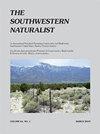吉拉鳟鱼(ONCORHYNCHUS GILAE)实验室热最大值与当前水流温度的比较评估
IF 0.2
4区 环境科学与生态学
Q4 Agricultural and Biological Sciences
引用次数: 0
摘要
摘要Gila trout(Oncorhynchus gilae)是美国西南部的一种标志性物种。鲑鱼在广泛的伐木、畜牧和采矿中幸存下来,目前受到气候变化、野火和广泛干旱的威胁。物种及其独特血统的长期保护和恢复取决于储存和转移到历史上有人居住的河流中。因此,鱼类的耐热性对于确定合适的栖息地和对变暖气候的潜在脆弱性至关重要。我们比较了三条线(Main Diamond、South Diamond和Whiskey Creek)孵化后的Gila Trout中的实验室衍生温度公制临界热峰值(Ctmax),以确定Ctmax是否在这些线之间存在差异。失去正确反应时的平均初始温度(28.9°C,SD=0.81°C)和最终温度(29.2°C,SD=0.74°C)在各线之间没有差异。我们将CTMAX值与2015年春季至2018年秋季Extant Gila Trout人口代表的三个排水沟的气温进行了比较。东福克-吉拉河排水以更极端的河流温度为代表。最高每日最高温度(即单一最高温度)在24.1至33.4°C之间,五条河流中有四条超过了Ctmax。每日最高气温为12.1至28.6°C,每周平均最高气温为19.9至31.1°C。下钻石溪每周平均最高气温有11次超过CTMAX。中福克-吉拉河和西福克-吉拉河流域的河流温度较低,不超过Ctmax。支持Gila Trout主要钻石和南钻石线的东福克-吉拉河流域内的间歇性伐木工人记录了300多天的干旱间歇性。继续长期监测溪流温度并与Gila Trout的CTMAX进行比较,可以帮助决定Gila排水中的哪些溪流适合Gila Trout的恢复、储存和转移。摘要吉拉鳟鱼(Oncorhynchus gilae)是美国西南部的标志性物种。这种鲑鱼在森林砍伐、放牧和采矿的漫长历史中幸存下来,目前受到气候变化、森林火灾和广泛干旱的威胁。该物种及其独特血统的长期保护和恢复取决于在历史上有人居住的溪流中成功地重新定居和重新安置。因此,鱼类的热耐受性将在确定适当的栖息地和对日益变暖气候的潜在脆弱性方面发挥重要作用。我们比较了三个血统(Main Diamond、South Diamond和Whiskey Creek)在养殖场养殖的吉拉鳟鱼的最高临界温度(TCmax),这是一个来自实验室的指标,以确定TCmax是否在血统之间存在差异。与矫直反应丧失相对应的平均初始温度(28.9°C,de=0.81°C)和最终温度(29.2°C,de=0.74°C)在血统之间没有差异。我们将TCMAX值与2015年春季至2018年秋季Gila鳟鱼现有种群的三个代表性排水沟中的溪流温度进行了比较。吉拉河的东福克排水沟以更极端的温度为代表。最高日最高气温(即最高气温)在24.1至33.4°C之间,五条溪流中有四条超过了最高气温。最高日气温在12.1至28.6°C之间,平均每周最高气温在19.9至31.1°C之间。下钻石溪的平均每周最高气温超过最高气温11次。中福克和西福克的吉拉河排水沟内的溪流温度通常较低,不超过TCmax。吉拉河东叉流域内的间歇性记录保存着吉拉鳟鱼的Main Diamond和South Diamond血统,在干旱期间记录了300多天的间歇性。长期持续监测溪流温度并将其与Gila鳟鱼的TCMAX进行比较,可以帮助做出决定,以确定Gila排水沟中的哪些溪流适合Gila鳟鱼的恢复、重新造林和重新安置。本文章由计算机程序翻译,如有差异,请以英文原文为准。
COMPARATIVE ASSESSMENT OF LABORATORY-DERIVED THERMAL MAXIMA OF GILA TROUT (ONCORHYNCHUS GILAE) WITH CURRENT STREAM TEMPERATURES
Abstract Gila trout (Oncorhynchus gilae) represent an iconic species of the American Southwest. The salmonid has survived extensive logging, livestock grazing, and mining, and is currently threatened by climate change, wildfire, and extended drought. Long-term conservation and recovery of the species and its unique lineages rely on stocking and translocation into historically inhabited streams. Thus, the fish's thermal tolerance is essential in determining suitable habitat and potential vulnerability to a warming climate. We compared a laboratory-derived temperature metric, critical thermal maximum (CTMax), in hatchery-reared Gila trout from three lineages (Main Diamond, South Diamond, and Whiskey Creek) to determine if CTMax differed among the lineages. The average initial (28.9°C, SD = 0.81°C) and final (29.2°C, SD = 0.74°C) temperature at loss of righting responses did not differ across the lineages. We compared the CTMax values with stream temperatures across three drainages representative of extant Gila trout populations from spring 2015 to fall 2018. The East Fork Gila River drainage was represented by more extreme stream temperatures. The maximum daily maximum temperature (i.e., single highest temperature) varied from 24.1 to 33.4°C, exceeding CTMax in four of the five streams. The maximum daily temperature varied from 12.1 to 28.6°C, and the mean weekly maximum temperature varied from 19.9 to 31.1°C. Mean weekly maximum temperature in Lower Diamond Creek exceeded CTMax on 11 occasions. Stream temperatures were cooler within the Middle and the West Fork Gila River drainages and did not exceed CTMax. Intermittency loggers within the East Fork Gila River drainage, which supports Main Diamond and South Diamond lineages of Gila trout, recorded over 300 days of intermittency during a drought. Continued long-term monitoring of stream temperature and comparison with CTMax of Gila trout could assist with decisions of which streams in the Gila Drainage are suitable for Gila trout recovery, stocking, and translocation. Resumen La trucha de gila (Oncorhynchus gilae) representa una especia icónica del suroeste de los Estados Unidos. Este salmónido ha sobrevivido una historia extensiva de tala forestal, pastoreo de ganado y minería, y actualmente se encuentra amenazado por el cambio climático, incendios forestales, y sequía extendida. La conservación a largo plazo y recuperación de esta especie y sus linajes únicos dependen de la repoblación y reubicación exitosas en arroyos históricamente habitados. Por lo tanto, la tolerancia termal del pez jugará un papel esencial en la determinación del hábitat adecuado y la vulnerabilidad potencial a un clima cada vez más cálido. Comparamos la temperatura crítica máxima (TCMax), un métrico derivado del laboratorio, en la trucha gila criada en criadero proveniente de tres linajes (Main Diamond, South Diamond y Whiskey Creek) para determinar si la TCMax difirió entre linajes. El promedio de temperatura inicial (28.9°C, DE = 0.81°C) y final (29.2°C, DE = 0.74°C) correspondiente a la pérdida de la respuesta de enderezamiento no difirieron entre linajes. Comparamos los valores de la TCMax con las temperaturas del arroyo en los tres drenajes representativos de las poblaciones existentes de la trucha de gila desde la primavera de 2015 hasta el otoño de 2018. El drenaje East Fork del río Gila fue representado por temperaturas más extremas. La máxima de las temperaturas diarias máximas (i.e., la temperatura más alta) varió de 24.1 a 33.4°C, sobrepasando la TCMax en cuatro de los cinco arroyos. La temperatura diaria máxima varió de 12.1 a 28.6°C, y el promedio de temperatura máxima semanal varió de 19.9 a 31.1°C. El promedio de temperatura máxima semanal en Lower Diamond Creek sobrepasó la TCMax en 11 ocasiones. Las temperaturas de los arroyos generalmente fueron más frías dentro de los drenajes del río Gila de Middle y West Fork, y no sobrepasaron la TCMax. Registradores de intermitencia dentro del drenaje del East Fork del río Gila, el cual sostiene los linajes de Main Diamond y South Diamond de la trucha de gila, registraron más de 300 días de intermitencia durante una sequía. Monitoreo continuo a largo plazo de la temperatura de los arroyos y comparación con la TCMax de la trucha de gila pueden ayudar con decisiones para determinar cuáles arroyos en el drenaje Gila son adecuados para la recuperación, repoblación y reubicación de la trucha de gila.
求助全文
通过发布文献求助,成功后即可免费获取论文全文。
去求助
来源期刊

Southwestern Naturalist
环境科学-生态学
CiteScore
0.50
自引率
50.00%
发文量
47
审稿时长
18-36 weeks
期刊介绍:
The Southwestern Naturalist (a publication of the Southwestern Association of Naturalists since 1953) is an international journal (published quarterly) that reports original and significant research in any field of natural history. This journal promotes the study of plants and animals (living and fossil) in the multinational region that includes the southwestern United States, Mexico, and Central America. Appropriate submission of manuscripts may come from studies conducted in the countries of focus or in regions outside this area that report significant findings relating to biota occurring in the southwestern United States, Mexico, and Central America. Publication is in English, and manuscripts may be feature articles or notes. Feature articles communicate results of completed scientific investigations, while notes are reserved for short communications (e.g., behavioral observations, range extensions, and other important findings that do not in themselves constitute a comprehensive study). All manuscripts (feature articles and notes) require an abstract in both English and Spanish.
 求助内容:
求助内容: 应助结果提醒方式:
应助结果提醒方式:


